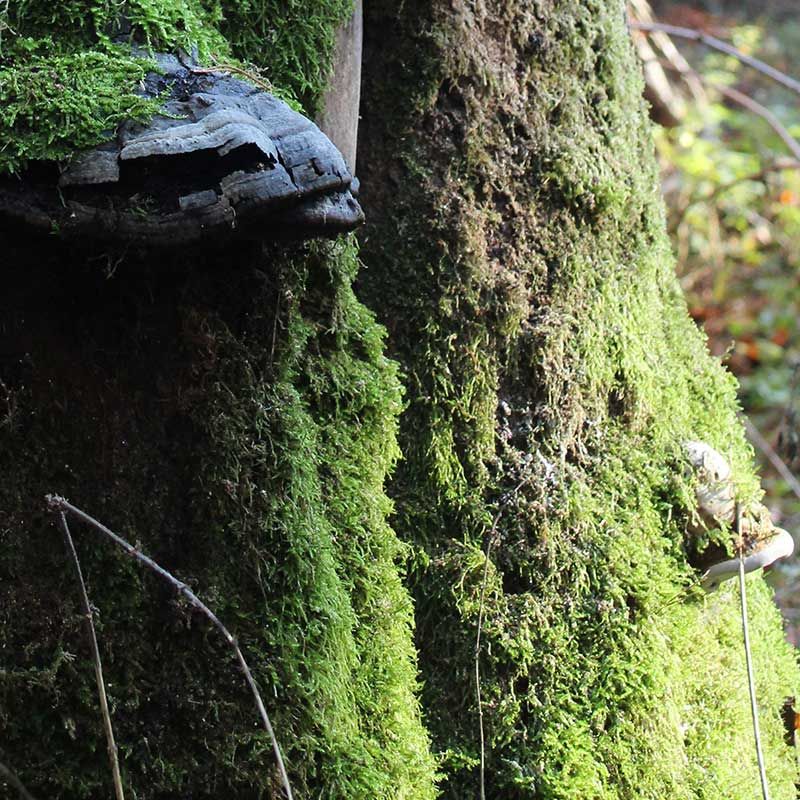
Resident of a commune: Rhinoceros beetle
Looking at the rhinoceros beetle (Oryctes nasicornis) you know what to expect! The males of the rhinoceros beetle carry a backward curved horn on their head in order to beat conspecifics, in the struggle for the female.
I found this specimen in a habitat tree together with a female and the rival.
Male European rhinoceros beetle

Male specimens like the one up here in the picture are about the size of a rectangular Lego brick (1,18 in). The horn can be up to 0,39 in long.
It is a sexually dimorpic species. The male's head is topped by a long curved horn (hence its common name), while the females have no horns.
Female European rhinoceros beetle

The females are slightly larger and fit next to a tealight (1.57 in).
With them, the horn is only slightly indicated.
As beetle mothers, they are very demanding and do not lay their eggs everywhere. Above all, it should be cuddly warm, because the beetles and their larvae like this very much.
The technical term for this is thermophilia (from ancient Greek θερμός thermós "warm" and φίλος phílos "loving").
If a garden is ecologically managed, it may be that larvae, so-called grubs can also be found in the domestic compost. Originally, the beetles were increasingly found in deciduous trees with a high proportion of deadwood, but have become well accustomed to the proximity to humans.
The life of the European rhinoceros beetle
The reason why the beetle can no longer be found too often is the destruction of its natural habitat.
Because he likes decomposed substrate inside old trees, or coarse woody debris and rotting wood stumps very much, habitats in old trees are rare. Such valuable trees are often simply removed from an exaggerated sense of order.
If the female has decided on a male, the eggs are laid sometime during the summer. After that, the larva passes through 3 larval stages. This means that the grubs are getting bigger and bigger as they feed on mulm or nutrient-rich plant parts inside the tree or compost.
The "finished" beetles need about 2-5 years until they hatch from the moment of egg laying.
If the home, e.g. the tree, should be felled in the meantime without having been examined for such important habitat sites beforehand, the complete brood of the female is lost.
If the finished beetles hatch because they were lucky enough to grow up in a recognizable habitat tree, they have several weeks to look for a partner and then the cycle starts all over again.
In this ash leaved-maple they have the best chances and I was very happy to have discovered it!
That's why it's so important to draw attention to habitat trees... endangered species could live here.
All that is missing is a sign so that EVERYONE can recognize it... and can protect it!

Resident of a commune: Gold-shining rose beetle
Surely each of us has seen him before and the award “Insect of the Year”, given to him in 2000, certainly contributed to his popularity:
The Golden Shining Rose Beetle (Cetonia aurata).
With its iridescent optics it inspires large and small, and I also find it incredibly engaging, which is why it often lands in front of my lens. The colouration of rose beetles is very variable and with a size of 14-20 mm it can shine in many metallic colours.
The large beetles (imagines) fly from April to September, but what hardly anyone knows, and where our habitat tree now comes into play, is that they lay their eggs in places that provide enough food for the growing brood, such as wood that has become friable and protein-rich.
One rarely gets to see this process. Or how often does one meet a beetle laying its eggs?!
Unfortunately, this creates the image as if the beetles are busy 24/7 on the meadows and in the garden. The most important detail in the cycle is often not known, namely that the brood can be found somewhere completely different. The eggs of the golden rose beetle hatch into young larvae, which become grubs that eat their fill in the duff of old trees or in humus soil from compost, and thus undergo a development period of 1-2 years until they become beetles. Also with the food, the beetles fall back gladly on the juices from old trees. Therefore, they can also be seen sitting on tree bark, licking the liquids produced during crack growth or bark damage.
Incidentally, they are not parasites, as flower pollinators and humus builders rather the opposite - a valuable part of the ecosystem.

Added value through more information!
The purpose of this blog is to generate added value...
However, I also need your help to do this, because I would like to respond specifically to conflicts of interest.
What are their main issues on site and what problems arise from the interface’s citizen-community-tree-nature conservation?
In future, my intention will be to publish articles here that highlight specific issues and address them with current study results and my experiences from citizen meetings, community council meetings, and building committees.
Feel free to contact me via the contact page about what is on your mind, or a solution you are looking for concerning a dispute of interest, and I will generate an article from it.
It would be my pleasure!
Your tree expert![]()







